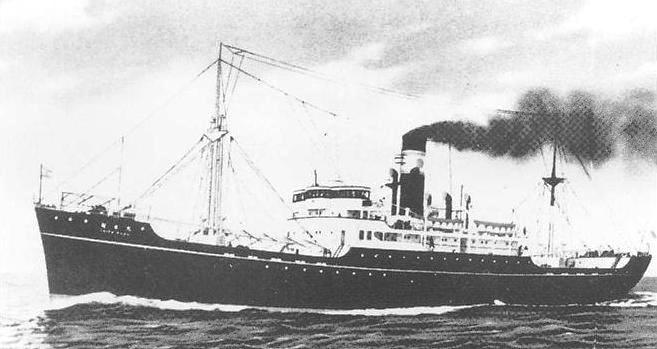RIKUGUN YUSOSEN
 (Sister IMIZU MARU prewar)
(Sister IMIZU MARU prewar)
IJA AIYO MARU:
Tabular Record of Movement
© 2017 Bob Hackett
1941:
Tsurumi, Yokohama. Laid down by Nippon Kokan K.K., as a 2,746-ton cargo ship for Oyo Kisen K.K., Tokyo
1941:
Launched and named AIYO MARU.
January 1942:
Completed.
24 December 1942:
Requisitioned by the Imperial Army (IJA) and allotted Army No. 947.
16 May 1942:
At 1030, AIYO MARU departs Minato, Tokyo Bay escorting an unnumbered northbound convoy consisting of BOKUYO (MUTSUYO), KENSHIN, SEIKAI, SETSUYO, SHOBU, TAIAN and TAIHOKU MARUs escorted by survey ship KOMAHASHI.
17 May 1942:
At 0735, arrives at Yokosuka.
8 December 1942:
AIYO MARU departs departs Tokyo Bay in West Convoy No. 61 bound for the Inland Sea consisting of ISSEI, KIZUGAWA, KASUGASAN, SHINNO and TAIKAI MARUs, KARI GO MARU and one unidentified merchant ship escorted by by minesweeper W-17.
28 February 1943: Operation 81-Troop reinforcements to Lae-Salamaua area:
At 2300, a transport convoy assembles outside Rabaul harbor consisting of AIYO, KENBU, KYOKUSEI, OIGAWA, SHINAI, TEIYO and TAIMEI MARUs and Naval Special Service Ship NOJIMA.
At 2330, the convoy departs the assembly point escorted by Rear Admiral Kimura Masatomiís destroyers SHIRAYUKI (F), ASAHIO, ARASHIO, TOKITSUKAZE, URANAMI, SHIKINAMI, YUKIKAZE and ASAGUMO and set course along the northern coast of New Britain, north-west from Rabaul before turning west and then south. The transports and destroyers are carrying 6,004 troops of the IJAís 51st Division and 600 Special Naval Landing Force (SNLF) troops.
The convoy is divided into two Divisions. No. 1 Division (starboard column) consists of SHINAI, TEIYO MARU (IJA No. 842) and KENBU MARU. No. 2 Division (portside column) consists of KYOKUSEI, OIGAWA and TAIMEI MARU and NOJIMA.
TEIYO MARU is carrying 1988 troops including 18th Army Headquarters, (29 men), 3rd Debarkation Unit, (163 men), 51st Division Headquarters, (58 men), 115th Infantry (946 men), 14th Artillery, (134) men, 51st Division Signal Company (240 men), 51st Division weapon duty party (49 men), 51st Division medical detachment, 3rd Field Hospital (25 men), 209th Airfield Battalion (5 men), 51st Engineer Regiment, (166 men) and 8th Shipping Engineer Regiment, (173 men). She also carries 2 100mm cannons, 2 field guns, 1 rear car, 1 passenger vehicle, 5 trucks, 1 tractor, 23 carts, 6 Daihatsu landing craft, 15 collapsible boats, 6 rowing boats, 500 unsinkable drums and 1,500 cubic meters of war supplies.
OR
2 March 1943: Battle of the Bismarck Sea:
At 0800, USAAF and RAAF planes bomb the convoy. USAAF B-17 "Flying Fortress" heavy bombers attack Army cargo ship KYOKUSEI MARU. She receives two direct bomb hits and sinks at 0926 at 05-02S, 148-14E (55 km NNW of Cape Gloucester, New Britain). Destroyers YUKIKAZE and ASAGUMO rescue 800 men and 110 drums, steam to Lae and disembark them, then rejoin the convoy. TEIYO MARU is lightly damaged by air attack NE of Cape Gloucester.
3 March 1943:
Dampier Straits. The battle continues as Allied aircraft make low-level bombing and strafing runs against the convoy. Rear Admiral Kimura is wounded. During the fighting, TEIYO MARU and cargo ships OIGAWA, AIYO, KENBU, SHINAI and TAIMEI MARUs are sunk as are destroyers ASAHIO, ARASHIO, TOKITSUKAZE and flagship SHIRAYUKI.
1 March 1943: Operation 81:
Departs Rabaul for Lae, New Guinea carrying 1,225 men of the IJAís 51st Division, the Navyís 3rd Air Defense Unit and 600 Special Naval Landing Force (SNLF) troops to reinforce the Lae-Salamaua area in a convoy consisting of cargo vessels KYOKUSEI, OIGAWA, AIYO, SHINAI, TAIMEI and KEMBU MARUs and transport TEIYO MARU carrying 6,000 troops of the 51st Division escorted by Rear Admiral (later Vice Admiral) Kimura Masatomiís (41) destroyers SHIRAYUKI (F), ASASHIO, ARASHIO, TOKITSUKAZE, URANAMI, SHIKINAMI, YUKIKAZE and ASAGUMO.
2 March 1943: The Battle of the Bismarck Sea:
USAAF and RAAF planes bomb the convoy. USAAF B-17 "Flying Fortresses" sink Army cargo ship KYOKUSEI MARU. On board is Major Nishikawa and the 115th Infantry Regiment, 51st Division. Also on board are infantry guns and mortars, trucks, landing craft, 2,000m3 of ammunition and fuel drums. One crewman and 485 troops of are KIA. Destroyers YUKIKAZE and ASAGUMO rescue survivors, steam to Lae to disembark them and then rejoin the convoy.
3 March 1943:
The battle continues as Allied aircraft make low-level bombing and strafing runs against the convoy. IJA transports are sunk including AIYO MARU carrying 51st Division troops, provisions, ammunition and five Daihatsu barges. (45 crewmen and 278 soldiers KIA),
OIGAWA MARU (78 crewmen and 1,151 troops of the 51st Division KIA), SHINAI MARU with men of the 51st Division and SNLF (18 crew, 45 gunners and unknown number of troops KIA), TAIMEI MARU with 51st Division and SNLF troops (44 crew and 35 soldiers KIA), KEMBU MARU with troops, compressed gas cylinders and drummed fuel (20 troops KIA) and TEIYO MARU carrying 1923 troops, two 100mm cannons, two field guns, one pick-up vehicle, one passenger vehicle, five trucks, one tractor, 23 carts, six Daihatsu barges, 15 collapsible boats, six row boats, 500 unsinkable drums and 1,500 m3 of war supplies (17 crewmen, 15 gunners and 1,882 troops KIA).
Rear Admiral Kimura is wounded during the fighting. Destroyers ASASHIO (lost with all hands, including Comdesdiv 8, Captain (Vice Admiral posthumously) Sato Yasuo (44), ARASHIO (176 survivors later rescued by YUKIKAZE), TOKITSUKAZE (19 sailors KIA) and flagship SHIRAYUKI (32 sailors KIA) are also sunk.
4 March 1943:
AIYO MARU survivors find TOKITSUKAZE down at the stern and listing to starboard, as she apparently had been since the previous day. They climb aboard drifting TOKITSUKAZE, only to have to jump back overboard as each attack takes place. She was sunk by enemy bombing close to dusk.
Author's Note:
Thanks go to Erich Muehlthaler of Germany.
Bob Hackett
Back
to IJA Transports





